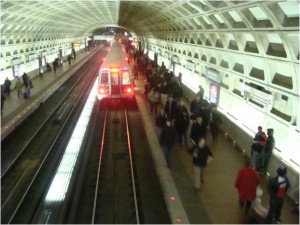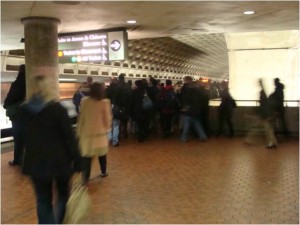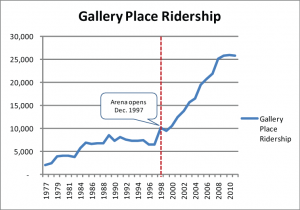Gallery Pl-Chinatown Capacity Improvements Study Underway
The Gallery Pl-Chinatown Station is the third-busiest station in the Metrorail system, with an average of 26,000 daily passenger boardings in May 2011. Combined with the Metro Center Station less than 1,000 feet away, these two stations facilitate downtown transfers on all five Metrorail lines, with the Yellow, Green and Red Lines at Gallery Place and the Orange, Blue and Red Lines at Metro Center. The Gallery Place Station consists of two side platforms that serve the Red Line on the upper level and one center platform that serves the Green and Yellow Lines on the lower level.
Redevelopment in the station area catalyzed by the opening of the Verizon Center in late 1997 has drastically increased the demand at this station, resulting in crowded conditions during the peak travel times throughout the station, including mezzanines, platforms and escalators. Weekday ridership has increased from an average of 6,500 boardings in 1997 to an average of 26,000 in 2011. Although ridership has stabilized over the past few years, more growth is expected in the near future with new CityCenterDC development currently under construction at the old convention center site at 10th Street and H Street NW.
Metro’s planners are currently undertaking the Gallery Place Station Access and Capacity Improvement study, with the purpose of identifying capacity constraints and developing improvement alternatives at the station. Similar to the Union Station Access Study, this study will provide simulations of the projected pedestrian environment on the platform at key milestone years, and will measure the effectiveness of the proposed capacity improvements.
To date, Metro’s planners have finished the assessment of existing conditions and analyzed the bottlenecks where passengers experience congestion during peak travel times. The main sources of congestion include several factors.
A unique feature of Gallery Place is the width of the Red Line platforms on the upper level, which are narrower than those at other core transfer stations due to the proximity of existing historic buildings directly above the cavern on G Street NW. In fact, the National Portrait Gallery was stabilized with 296 piles, according to The Great Society Subway (Schrag, 148). The buildings on the north side of G Street (just above the westbound Red Line platform) are also stabilized by piles.

Passengers must walk more than one car-length from the end of the platform to board a six-car train.
On the Red Line platform, heavy congestion occurs when passengers arrive at the westbound platform from the Green and Yellow lines and from the 7th Street entrance. When a six-car train arrives, these passengers must walk more than one car-length down the platform to reach the first available door: the trains pull to the front of the platform for safety reasons while the system is being operated using manual train control. (Metro has been operating in manual mode since June 2009.) Due to this, boarding passengers are often met by a wall of disembarking passengers seeking to transfer or exit from the east side of the station. This problem is exacerbated because waiting passengers do not spread evenly across the platform, and instead tend to cluster near the back of the train at the most crowded part of the platform. These factors combine to result in delays to both passengers and train operations.

Passengers at the “T” shaped intersection of the Red Line platform and the connection with the lower platform and upper mezzanine.
The “T”-shaped junction connecting the upper and lower platforms results in a major chokepoint for passengers making a transfer in the peak hour. Passengers only have one choice of direction, unlike at other “cross-shaped” transfer platforms, where passengers can choose to move to the side of the platform that is less congested.
Passengers on the lower level experience significant queues at the escalators during peak hours. Passengers must also cross over the escalator bank at the upper platform level to continue to the 7th Street/F Street mezzanine.
The following video is a simulation that illustrates the existing conditions (using 2010 data) on the Red Line platform at Gallery Place-Chinatown during the afternoon peak period. The 2010 simulation will be used in Metro’s work for two purposes. First, the simulation allows Metro to calibrate the pedestrian simulation model and to be confident that the model is correctly reflecting existing pedestrian behavior. Second, the model serves as a point of comparison with future improvements that will be tested so that the degree of improvement offered by each design alternative can be assessed compared to current conditions.
The Red Line platform connects to the lower level and the upper mezzanine in a “T” shaped intersection. Individual passengers are represented as colored dots, with each color representing an eventual destination. For example, pink dots represent passengers transferring from the lower level to the westbound Red Line. While most dots are narrow, the wider dots illustrate passengers with luggage or strollers who use the wider fare gates for easier Metro system access and egress. The simulation shows the severe crowding that occurs regularly as Metrorail passengers and others wait to board trains at the rear of the Red Line platform.
In the coming months, Metro will identify and evaluate a group of improvement alternatives for structural analysis and impact assessment while also investigating some short-term solutions. We’ll be posting additional details as the study progresses. In the meantime, let us know your thoughts on the study.




A comparatively cheaper suggestion: stop running trains to the end of the platform. Particularly on the Red Line platforms, I’ve seen most of the congestion being a result of the T (lots of crowding to the east) but when the train arrives: there’s then a collective surge to catch up to the back of the train, occurring along both directions of the Red Line.
I’ve been under the impression that while on manual control, trains can’t stop sooner because the operators forget how long their train is… not all-together unreasonable — my memory certainly isn’t the best, either, especially if I have only two numbers that I use day-in / day-out.
But if that is indeed the issue: surely there must be some way to indicate to the operator what the length of their train is. Perhaps taking the data feeding into the PIDS and post it somewhere in the tunnels approaching the station (though this would have to address sensor issues which sometimes report a 2-car train).
Or… a cheap route that just might work, barring human error: stick some Velcro in the operator’s cabin. Then laminate some signs with a big bold 6 on one side and an 8 on the other, including the other half of the Velcro on each side. When assembling the trains: designate someone to flip the sign so the # of cars is facing the operator.
@Bossi Er, the above isn’t an end-all “solution”; just intended to at least contribute what I’d guess could be a pretty considerable benefit. Combined with some delineation on the platforms of where the front & end of the train would be for the 6- and 8- car combinations, that could also help the passengers properly align themselves with where they need to be.
I agree with @Bossi — let’s start by ordering the train operators to park the trains at the proper location in Gallery Place instead of pulling all the way up. I know safety is a big concern after the Red Line crash, but honestly, the rush hour crowding is a bigger safety concern than braking the trains. One of these days, someone is going to get crushed underfoot, or knocked off the edge onto the tracks.
If I recall, the reason we are parking trains at the front of platforms is that operators were forgetting whether they had 6 or 8 car trains; an 8 car train driven like a 6 car train means doors opening in tunnels. I wouldn’t want to create a new safety issue by adjusting where the trains are supposed to be stopped.
Plus, this is the “long-range planning” website. Shuffling cars around may work for a while, but it’s deck chairs on the titanic if we don’t also look into long-term solutions that plan for increased ridership down the road.
In Rome, they actually have signs on the ceiling designating “lanes” for pedestrians in long transfer corridors to walk on the right side of the hallway. I wonder if Metro could do two simple things – one is put duct tape on the floor where the last doorway will open up on a six car train. That location won’t change for a year or more, and I’ll happily spring for a roll of duct tape. :)
The other would be to put a plastic overhead sign on the WB platform, at the same height as the pylons that are on the platforms, with red and green signs each covering half the width of the platform, suggesting that passengers boarding keep to the side of the platform closer to the train, and those walking towards the back (and the Y/G lines) keep towards the outside wall. This would minimize pedestrian conflicts all the way to the escalators.
@Bossi, et al. Thanks for the comments so far. As noted in the post, we are investigating some short-term solutions that may help alleviate the platform congestion, but this study is focused on long-term improvements. Keep in mind that future population and job growth, along with new service patterns (e.g. Dulles Rail, Blue/Yellow Realignment) will add a good deal of passenger demand to this station in the future. Even with 100% 8-car trains, by 2030, some physical improvements will need to be made.
Keep an eye out for future posts where we will show simulations of future scenarios and detail the alternatives that we are modeling. In the meantime, what sorts of station improvements do you think would help the problem, given the information in this post? Thanks again.
Why don’t you consider running the yellow line to Fort Totten during rush hour? Why force Red/Yellow transfer to only one station and that one already over used?
@Vicki: The Yellow Line terminates at Mt. Vernon Square during rush hour because there is a pocket track that can be used for making the turn back southbound (a pocket track is actually a short length of third track located in between the two service tracks that is used for turning trains around and storing gap trains). At Fort Totten, there is no such pocket track, and the trains must switch between the two active service tracks using a rail crossover. This process takes several minutes, and during the peak, Green and Yellow Line trains are running every 3 minutes. Off-peak, though, trains run every 6 minutes, thus providing enough time to make the crossover.
Next year, when Metro reorients some rush hour trains to run from Franconia-Springfield to Greenbelt (see http://www.wmata.com/about_metro/news/PressReleaseDetail.cfm?ReleaseID=5062), there will be additional opportunities to transfer at Fort Totten.
Vicki raises an interesting issue. Should the study of Gallery Place crowding include the impact of building the needed pocket track at Fort Totten?
My daily observation of the PM transfer crowding going from Yellow/Green to Shady Grove bound Red line trains is that some simple markings on the platform for where the 6 car train will end and some signs to move down the platform would greatly help.
The biggest problem with WMATA’s station designs is the limited vertical access capacity. In New York and some Chicago stations you can usually enter or leave a platform at several locations along the platform. In DC access is very limited and customers trying to leave a train or platform conflict with individuals trying to reach the platform or move along the platform. Wider platforms only partially mitigate the design error.
This is absolutely the worst station in the system. During rush hour, it is insanely hard to make a transfer from Red to green/yellow. If a red line is even a few minutes behind schedule due to a delay, the capacity at the station is unbearable. I’m always afraid myself or someone else will fall on the tracks. This station should be a TOP priority
where did you get the statistics for this simulation? for the amount of people in and out and average wait time
@question: We use ridership data from Metro’s ridership datamart, which provides time-based origin-to-destination trip data (this data is collected at the faregates). For estimating transfer movements, we have to estimate using a complex trip model, which we also use for other ridership forecasting activities. We also verified this with in-person observations and passenger counts at each mezzanine and escalator/stair during peak ridership periods. The train arrival simulation uses the schedule and factors in some variability based on observed data from our operations databases. Finally, we used a pedestrian modeling software to run the simulations and calculate the level of congestion, average travel times, etc.
I’ll post an update on this project with more information to restart the conversation on this project.
3 years later, and no changes that I’ve noticed, other than the occasional escalators reversed.
Crowding on the westbound platform continues to be really dangerous.
Is it really that big of a deal to stop 6-car trains at the back of this platform? Can operators seriously not handle that?